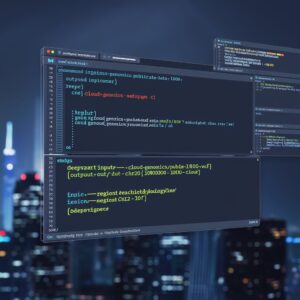DeepVariant is an advanced tool developed by Google for genome sequencing. It uses deep learning techniques to convert raw genomic data into accurate genetic variants. This cutting-edge technology is crucial for research in genetics, medicine, and biology, helping scientists and researchers better understand genetic variations and their implications for human health.
When running DeepVariant, the tool creates several intermediate files during processing. These files are stored in a temporary directory, typically located at paths like /tmp/tmpcgn0s8jv. Efficient management of this directory and its contents is essential for optimizing performance and resource usage, particularly when processing large datasets.
Why Re-Using the Directory for Intermediate Results Matters?
Re-using the directory for intermediate results in /tmp/tmpcgn0s8jv can significantly improve the efficiency and speed of DeepVariant operations. Here’s why this approach is beneficial:
Time Efficiency:
By re-using the existing directory for intermediate results, DeepVariant can skip the step of creating a new temporary directory for each run. This saves time, especially when processing large amounts of data.
Resource Optimization:
Re-using directories helps optimize the use of storage and memory resources. Instead of allocating new resources for each run, DeepVariant can use existing ones, reducing the strain on your system.
Consistency:
Using the same directory for intermediate results ensures consistency in data processing. This can be particularly important for reproducibility in scientific research, where results need to be replicated exactly to verify findings.
How to Set Up DeepVariant for Re-Using Intermediate Directories?
Setting up DeepVariant to re-use the directory for intermediate results involves a few simple steps. Here’s a basic guide:
- Install DeepVariant: Before you can use DeepVariant, you need to install it on your system. This can be done by following the instructions on the official DeepVariant GitHub page.
- Create a Persistent Directory: Instead of letting DeepVariant create a temporary directory every time it runs, create a persistent directory. You can do this using the command
mkdir /tmp/tmpcgn0s8jv. - Configure DeepVariant to Use the Persistent Directory: When running DeepVariant, specify the path to the persistent directory you created. This can usually be done by adding a flag to the command line, such as
--intermediate-results-dir /tmp/tmpcgn0s8jv. - Run DeepVariant: Once everything is set up, you can run DeepVariant as usual. The tool will now use the persistent directory for intermediate results, saving time and resources.
Potential Challenges and Solutions
While re-using the directory for intermediate results in /tmp/tmpcgn0s8jv has many benefits, there are also some potential challenges to consider:
- Storage Limitations: If the directory becomes too full, it can lead to performance issues. To avoid this, regularly monitor the directory and clear out old files that are no longer needed.
- Data Integrity: Re-using the same directory could lead to data corruption if files are accidentally overwritten. To prevent this, ensure that file names are unique or implement a system to check for existing files before writing new ones.
- Security: Storing intermediate results in a persistent directory could expose sensitive data to unauthorized users. To mitigate this risk, set appropriate permissions on the directory and use encryption if necessary.
Best Practices for Managing Intermediate Results in DeepVariant
To get the most out of DeepVariant and ensure efficient management of intermediate results, consider the following best practices:
Regular Maintenance:
Periodically check the persistent directory for any unnecessary files and remove them. This will help keep the directory organized and prevent it from becoming too cluttered.
Automated Scripts:
Consider writing scripts to automate the process of managing intermediate results. For example, you could create a script that automatically deletes files older than a certain age or moves them to a different directory for archiving.
Backup Important Data:
While intermediate results are often temporary, some may be important for future analysis. Make sure to back up any files that you may need later to avoid losing valuable data.
Advanced Configuration Options for DeepVariant
For users who want to take full advantage of DeepVariant’s capabilities, there are several advanced configuration options available. These options can help you fine-tune the software to better suit your needs and improve performance even further.
Customizing Output Formats:
DeepVariant allows users to specify different output formats for their results. This can be useful if you need to integrate the results with other software or if you have specific requirements for data analysis.
Parallel Processing:
If you have access to a powerful computer or server, you can configure DeepVariant to use multiple processors or GPUs. This can significantly speed up the processing time, especially for large datasets.
Adjusting Sensitivity and Specificity:
DeepVariant includes options to adjust the sensitivity and specificity of its variant calling. This allows you to balance between identifying more variants (sensitivity) and reducing false positives (specificity), depending on your research needs.
Insights and Analysis on DeepVariant Re-Using the Directory for Intermediate Results
Re-using the directory for intermediate results in /tmp/tmpcgn0s8jv is more than just a technical tweak—it represents a shift towards more efficient and sustainable data processing practices. By re-using resources, we can reduce waste and make better use of the computational power available to us.
From a broader perspective, this approach aligns with the principles of sustainable computing, which emphasize reducing resource consumption and minimizing environmental impact. In the context of bioinformatics and genome sequencing, where large amounts of data are processed daily, even small improvements in efficiency can have a significant cumulative effect.
Moreover, the practice of re-using directories and managing resources more effectively can be applied to other areas of research and data analysis. As we continue to generate and process more data than ever before, finding ways to optimize resource usage will become increasingly important.
FAQs
1 – What is the purpose of re-using the directory for intermediate results in DeepVariant?
Re-using the directory helps save time and resources by avoiding the need to create new temporary directories for each run, leading to more efficient processing.
2 – How do I set up DeepVariant to re-use a directory for intermediate results?
Create a persistent directory, configure DeepVariant to use it with the --intermediate-results-dir flag, and run the tool as usual.
3 – What are the risks of re-using a directory for intermediate results?
Potential risks include storage limitations, data corruption, and security concerns. These can be mitigated with regular maintenance, unique file naming, and proper permissions.
4 – Can I use any directory for intermediate results in DeepVariant?
Yes, you can specify any directory for intermediate results, but it’s best to choose a directory that is secure and has enough storage capacity.
Conclusion
Re-using the directory for intermediate results in DeepVariant is a practical and effective strategy for optimizing performance and resource usage. By following the steps outlined in this guide and implementing best practices, you can ensure that your data processing is both efficient and reliable. As genome sequencing and bioinformatics continue to evolve, approaches like this will become increasingly important for managing the vast amounts of data generated by these technologies.




